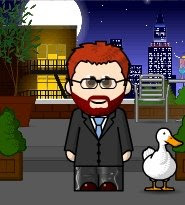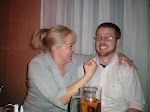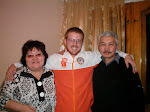This long, rambling account of a much needed vacation in the South of Kazakhstan is brought to you my instant MacCoffee packets and Kazkommerce ATM cards.
Two weeks ago, I was bundled up in a coat, hat, boots, and gloves, rushing back and forth from school to finish my last day of work before heading south on the Petropavlovsk-Shymkent afternoon train. In the middle of a mid-march blizzard I taught six lessons, held an amazing English club where we talked about cultural differences between the US and Kazakhstan, packed up my backpack and guitar case, and was out of town, southbound and smiling. Six out of the seven North Kazakhstan Oblast (NKO) PCVs were on the train for a mere 31.5 hours, picking up other work-tired and vacation-eager volunteers in one or two-hour increments along the way. We rode in economy class, or what is called steerage on a ship. On the other trips that the PC had booked for us we rode business class, where there are four people to a private “Coupe” (Russian: koo-PAY). This was our first train ride that the PC didn’t directly buy our tickets for us, but rather deposited the money for Kupe tickets while we were responsible for booking the tickets ourselves. Kaz PCVs have a common practice of taking the Kupe money, buying Platscart (steerage) tickets, and using the difference (about $80 roundtrip) to pay for food and lodging during the trip. And thus we traveled, in bunks smaller and less comfortable than previous trips, surrounded by 30% more people and without and doors or partitions. On the way south we met a couple of older ladies who were from Russia on their way to Kyrgyzstan to drink vodka for a birthday celebration. As we passed Astana and Karaganda we started noticing this green substance on the side of the tracks. My first guess was radioactive bacterial slime, as you can never quite predict what you’ll see from day to day in KZ, and radioactive bacterial slime is just as likely as most other things. It turns out I was wrong; it was grass. I realized that I hadn’t seen grass (at least not the green variety) since moving to Petropavlovsk in November. Crazy.
We arrived in Shymkent at 2:00 am and were greeted by Mika, a Kaz-18 who organized much of the trip for us. In total there were about 80 PCVs (Kaz-17s, 18s and 19s) who made it to Shymkent at some point during the weekend. She took us to the apartments reserved for us, where we slept for a few hours before beginning our three-day raid on the city of plof (Uzbek rice dish), shashlik (barbecue kabob), and Shymkentskoye peeva (local beer). Shymkent is the unofficial capital of traditional Kazakh culture and is, by my estimation, 90% Kazakh-populated. In our group we had a few incidents where the cab drivers didn’t speak Russian, giving us a heightened sense of foreignness that we hadn’t experienced since August.
Day 1: We woke up fairly early, having slept and lounged for most the 1.31 day-long train ride, and spent the day on an unorganized walking tour of the city. The SKO volunteers had prepared maps for us with key cafes, restaurants, monuments, museums and parks, so we had little trouble finding our first plof restaurant keep us full and happy as we soaked in the 21+ C (70+ F) weather. Shymkent has a Museum of Repression that we briefly visited before spending a couple hours tossing a Frisbee in a park. We met some local high school boys that wanted to learn how to manage this strange contraption, so we taught them… or at least tried. It’s amazing how difficult a Frisbee is for people who’ve never thrown one.
For this Spring Break trip Forrest, Mike and I planned to make a video to put up online, consisting of our travels and fun times, but also some interviews with PCVs and locals along the way. I spent much of all three days in Shymkent with my digital camera interviewing PCVs about their PC experience so far and other interesting topics. The video will be out hopefully by early May, as we took about 2.5 hours of footage and hope to cut it down to a manageable 20-30 minute video. That evening we rented out a large room in a café and met all together with the 60 or so PCVs that were in town so far. I met many Kaz-18s for the first time, and was able to reunite with Kaz-19’s I hadn’t seen since November. We had a great time laughing and sharing stories from site, as well as reminiscing about the good (and bad) times during PST.
Day 2: The SKO PCVs not only booked our apartments and cafes, but also a group excursion we took to the small city of Turkistan. About 3 hours northwest of Shymkent, Turkistan is a tourist spot which the Lonely Planet guide claims houses “Kazakhstan’s greatest architectural monument.” It is home to the Kozha Akhmed Yasui Mausoleum, which is a minor Muslim pilgrimage site and the resting place of a prominent Sufi teacher. The mausoleum is impressive with its large outer wall, massive blue dome, and towering minarets. The inside is open to the public and houses a large cauldron lit from below. It has been restored many times, and now most of it is plastered over with white walls, the original tiles only on display in glass boxes. The original bricks line many parts of the interior and it is believed that one’s sins can be erased by walking the course of the building while touching the walls. Photographs were unfortunately prohibited, so my relation of the Islamic faithful will remain written and verbal. We had an English-speaking tour guide that explained the uses of the many rooms, including prayer rooms, a solitary confinement “purification” chamber and a kitchen. It was also the practice to enter the building in a normal fashion, but to exit backwards, remaining facing the interior of the building. We found shashlik for lunch, making a very filling and delicious meal for under $2, something that only Taco Bell can claim (neither pretending to be nutritious). That night, after showering off the grime of a day outdoors and comparing sunburns, we headed to a dance club to enjoy a night on the town.
Day 3: Saturday was Nauryz, the Kazakh New Year’s Holiday, and the agenda showed no signs of letting up. We got up and went to the city square, where yurts (traditional nomadic Kazakh dwelling places) and stages had been constructed. There you could listen to Kazakh orchestras and try traditional Kazakh foods like fermented mare’s milk and horse sausage, both of which I had tried in training and didn’t feel the need to have again, especially at 10:00 am on an increasingly hot day. We eventually made it out to the hippodrome where the main festival was taking place.
We got out of the taxi to see throngs of people meandering across a large square scattered with shashlik stands, bands, dancers, carnival games, and parachuting men dropping small prizes. On our way across the square to the horse track on the other side, we saw several tables set out with a full spread of food – baursak (fried dough), meat, cheese, juice, soft drinks, fruit, candies – and we stopped to ask how much a meal would cost. The woman managing the area said, “Sit down, it’s free.” Astonished, and not quite believing, we sat, we ate, we made guesses as to how they were going to trick us and end up making us pay lots of money. We saw a large skillet preparing plof and asked our hostess how much a plate would cost. She said, “It’s free. It’s our holiday.” We ate and ate, marveling at the generosity that doesn’t seem to happen all that often these days. We left with big smiles and full stomachs and went to see the horse games. At the hippodrome while waited for the games to start we met a family of five from North Carolina vacationing in South Kazakhstan and had a nice long conversation with them. We were interested to hear why someone would choose KZ for a vacation destination, while they were just glad to hear some English after two weeks in country. The games began, as we watched several races and other traditional games.
The two most interesting games involve either kissing or dead goats. I’m just glad they haven’t combined the two. In the first, a man and a woman, on two separate horses begin to race along the straight length of the track. The woman gets a small head start, and the man tries to catch her and land a kiss before the finish line. After they cross the finish line, they turn around and race back to the starting line, this time, the woman chasing the man. If he landed the kiss, she can only slap and punch with her hands; if he didn’t catch her, she gets to use a small whip. Good family fun for everyone. The second game is called Kok Par and is best described as Dead Goat Polo. Two teams of men on horseback play on a football-sized field with two goals or large baskets. There is a dead goat on the ground which the players struggle over to grab and transport to their designated goal. Once again, good family fun for everyone. We ate ice cream (not free), got sunburned (again) and headed back to the hotel to transition to the next event – basketball.
We, the NKO PCVs, had challenged the SKO PCVs to a basketball match. The SKO kids found a court and a ball to put our skills to the test, only to be shamed on their home court, 20-18. They even had jerseys and a full side of subs. With our single substitute and mix-and-match uniform we managed to claim the title of best basketballing PC Oblast. That night we celebrated our victory, made burritos for dinner, and relaxed from our strenuous day.
On Sunday we got a wake up call at 8:00am saying that the management wanted us out of the building by 9:00 am. We evacuated and bought bus tickets to Almaty for our In-Service Training (IST) that would start on Monday, and spend the day at a Turkish café with free wireless internet. I took my picture by a store called “Kentucky” (pronounced Ken-TOO-kee) and found an Apple store inside the local mall. That evening we loaded up for a twelve-hour bus ride from Shymkent to Almaty.
Subscribe to:
Post Comments (Atom)
.jpg)








No comments:
Post a Comment